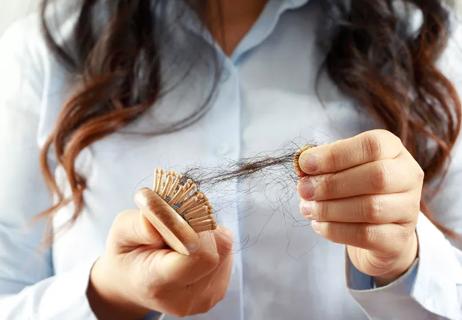Experiencing constant fatigue, shortness of breath and chills could all be signs of low iron

You often wake up tired, even after a good night’s sleep. You always feel cold and reach for a sweater, no matter the temperature. Your nails are looking a little dry lately, despite using moisturizer.
Advertisement
Cleveland Clinic is a non-profit academic medical center. Advertising on our site helps support our mission. We do not endorse non-Cleveland Clinic products or services. Policy
While your mind may go to iron deficiency to explain these symptoms, you’re still unsure. But it’s true: Low iron levels can cause some of these reactions.
But what might cause low iron levels?
“Causes of an iron deficiency can range from poor diet to a serious illness,” says family medicine physician David Brill, DO. “Other factors to consider are your age, sex recorded at birth and medical history.”
It can be difficult to determine whether your symptoms are due to an iron deficiency, as headaches, chills and fatigue can occur for various reasons. But Dr. Brill shares some signs of iron deficiency and how to get properly diagnosed.
Your body uses iron, a mineral, to make hemoglobin. This helps your blood carry oxygen throughout your body. If you aren’t getting enough iron, your hemoglobin levels drop and this can limit oxygen flow. This is what ultimately causes iron-deficiency anemia — the most common type of anemia.
If you show up at the doctor’s office looking pale, especially around the eyes, and complaining of constant chills and exhaustion, your provider is likely to test for iron deficiency. Here are six signs to watch for:
You look in the mirror and feel like you’re a bit paler than usual. Iron deficiency may cause you to appear pale, especially on your face, lips and inner eyelids.
Advertisement
This is because the hemoglobin in our red blood cells is, well, red. If you don’t have enough hemoglobin (because of low iron), this can affect the color in your face.
You may also notice a yellowish color in your complexion that wasn’t there before.
Being tired occasionally is one thing, but if you’re experiencing fatigue related to iron deficiency, it will feel like exhaustion on another level. You may also feel a general weakness in your body, like you don’t have the energy to do things you usually can. If you constantly feel exhausted with no clear cause — even after getting enough rest — it could be a sign of low iron levels.
As iron is tied to how oxygen moves in our body, it’s no surprise that your breathing can be affected by iron deficiency. Iron is essential for oxygen transport in the body.
Low iron levels can reduce oxygen delivery to tissues, leading to shortness of breath, especially during physical activity.
If you find yourself out of breath while doing everyday tasks, this may be a sign of low iron.
You used to handle the cold just fine. But lately, you find yourself shivering when the air conditioner is on or when the temperature drops.
Because iron-deficiency anemia causes poor blood circulation, this can affect the way you feel the temperature. In particular, people with anemia often experience chills or a constant feeling of being cold. It’s common to feel cold with low iron, especially in your hands and feet.
This is a strange one, but it does happen! In some cases, people with iron deficiency may experience cravings for non-food items such as ice, dirt or even hair. This condition, also known as pica, can have a lot of causes, but low iron levels can be one of them.
Iron deficiency can cause brittle or spoon-shaped nails (koilonychia). And although not as common as other symptoms, iron deficiency can also contribute to hair loss, particularly in women.
If you think you’ve been experiencing signs of iron deficiency, the best thing to do is to talk to a healthcare provider. Blood tests can identify an iron deficiency, but that’s only part of the evaluation during an office visit.
“We always want to listen to what you tell us,” Dr. Brill states. “A good history and physical exam are tools that no amount of technology can beat.” Lab tests then confirm the diagnosis. “I would recommend annual lab screenings so we have a trail to look back on if there are any changes with time,” he adds.
Your healthcare provider will first determine what’s causing your iron deficiency. Treatment will then focus on both the low iron levels and the underlying cause.
For example, if your diet is the culprit, they may recommend changing to or adding more iron-rich foods to what you eat daily. Dr. Brill recommends working in food with a good source of iron like:
Advertisement
Your doctor also may recommend an iron supplement available without a prescription.
“There are pros and cons for every type of treatment,” Dr. Brill points out. “We take into account the cause and the severity of your symptoms. If the severity is life-threatening, we can do a blood transfusion. This, however, is not the answer for everyone.”
People who may be at higher risk of developing iron deficiency include:
Advertisement
Your body can send you a message about iron deficiency in a lot of ways. Whether you’re experiencing persistent chills, constant fatigue or shortness of breath, these could all be signs that your body isn’t getting enough iron.
Typically, iron deficiency can be treated through changes in diet or by taking iron supplements. But sometimes, it can be a sign of a more serious medical condition, so it’s always best to talk to a healthcare provider.
Advertisement
Learn more about our editorial process.
Advertisement

The benefits of iron span your whole body, from your blood and your brain to your immune system and more

This pairing has long been thought to help your body better absorb iron

Pump up your iron intake with foods like tuna, tofu and turkey

Iron plays a vital role in hair growth and health

If the area is bleeding a lot or the wound is near your face or genitals, you likely need a specialist’s care

Lots of things can activate the herpes simplex virus, from the common cold and cold weather to cracked skin and cosmetic procedures

Honey can help make a sore throat more bearable by tamping down inflammation and coating your throat

Internists see people 18 and over, while family medicine physicians can treat people of all ages — but from there, they have more similarities than differences

The ‘sunshine vitamin’ is found naturally in some fish and is added to other foods

Autism and ADHD often go hand in hand, giving rise to the term AuDHD

The Yuzpe regimen is less effective than other forms of emergency contraceptives, and it’s associated with more side effects